Coaching points for defensive post players
Elevate the performance of your team by focusing on an individual’s T.I.P.S.
This teaches man-to-man defensive post players the proper techniques, positioning, location and stances to successfully defend any type of offensive post action. With repetition, and with the coaching staff teaching solid fundamental methods, these defensive skills and techniques improve the team’s defensive post play.
Coaches can improve each player’s defensive game by focusing on their T.I.P.S. — Techniques, Intensity, Positioning and Stances. Better defenders results in an improved team defense, and all T.I.P.S. should occur regardless of where the ball is on the court.
This article gives coaches a vehicle in order to teach and demonstrate the specific techniques to counter different offensive actions used against their defenses. This gives coaches extensive examples of these offensive attacks in a drill. That way, coaches are prepared to teach the possible offensive schemes that are used.Some of these specific details and various actions that should be implemented are:
For a coach to have a successful program, the initial step is to find the most efficient and effective way to play defensively.
- Positioning of post defenders against ball-side and help-side offensive players.
- Lane exchange (block to block) cross-screens.
- Lane exchange screens with screeners flashing back to the ball.
- Post “seal-offs” after skip passes.
- Help-and-recover on perimeter baseline drives.
- High-post flash action.
- Low-post flash action.
- High post to weak side block diagonal screening action.
- Defending various types of ball screens and locations of ball screens.
- Random movement by post players.
- Box outs after jump shots.
- Defensive rebounds and outlet passes after box outs.
- Transition from defense to offense on missed shots into primary and secondary fast breaks.
- Transition from defense to offense on turnovers into primary and secondary fast breaks.
- The transition from offense back to team defense.
The drill is formatted so that coaches could devise other scenarios that post players need to work on.
Basic techniques
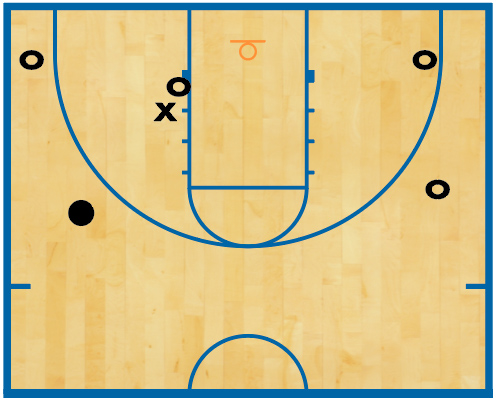
Reacting quickly to the offense is a necessity for defensive success. Knowing and instinctively changing defensive locations and stances after every offensive action helps make strong individual defenders, which leads to a strong team defense.
These instinctive reactions can only result after repetitions of the offensive actions created in game-like practice drills. Remember, every time the ball or an offensive player moves, every defender must adjust their own “ball-you-man flat triangle” with the correct defensive stance. Every player must master this.
Every time the ball is passed, perimeter defenders should work on jumping to the ball — a reaction that all defenders must learn. Combining defensive work on the perimeter with work on post defense saves coaches and players time that can be devoted to other aspects of the game. This technique is taught and reinforced with one simple phrase: “jump to the ball.”
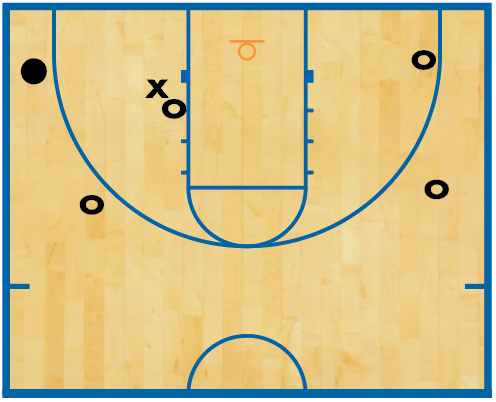
» RELATED: Taking away a dominant post player
Ball-side post defenders should always be in a three-quarter front position on the ball side of the offensive player. If the ball is high, these post defenders should be on the high side of that offensive post player (DIAGRAM 1). If the ball is in the deep corner, the post defenders should be on the low side of that offensive post player (DIAGRAM 2). The ball-side post defender should have their ball-side leg and foot around and in the passing line, and the hand of the “long arm” (the arm furthest from the post player) should be directly in the passing line with the palm out and thumb down. The “contact arm” (the arm closest to the opposing post player) and the back of that same hand should be in the chest of the post player.
We use the phrase “It’s a battle of the feet” to emphasize the importance of the ball-side foot. The ball could easily be passed on the perimeter either down to the ball-side deep corner or passed up from the corner to the wing area near the free-throw-line extended, which changes the placement of the ball from high to low or low to high. If a defender has to switch from the high side to the low side of the offensive postman, we insist that the defender shuffle around belly-to-belly as quickly as possible. We stress to post defenders to determine the favorite spot of the offensive player and try to beat them to that spot.
Greater intensity
Players that are taught with the necessary repetitions to learn and practice skills can gain confidence. Once confidence is elevated, those defensive players possess the freedom to increase their intensity, since they’re less concerned about making mistakes.
The coaching staff must develop a “never give up” attitude. A player’s success in structured practice settings and detailed defensive education helps develop that high level of intensity needed for defensive success.
Defensive positioning
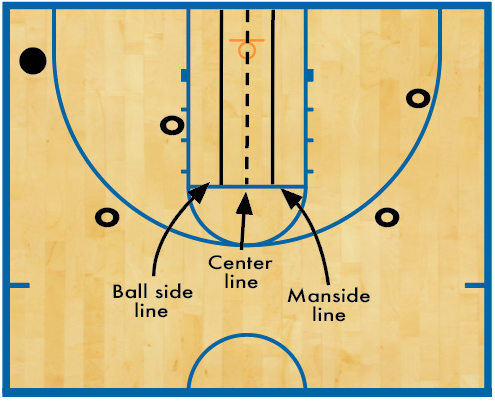
All off-the-ball defenders in the post or perimeter area should be in a “ball-you-man flat triangle” position in relationship with the ball and their man. All defenders who are two or more perimeter passes off of the ball should form their triangle so that they’re one to two steps off the passing line between the basketball and their man. Anytime there is movement of the ball or the offensive player, each post or perimeter defender’s “ball-you-man flat triangle” should be quickly adjusted.
Defenders who are guarding offensive players two or more perimeter passes away from the ball should be in a location that is dependent upon whether the ball is above or below the free-throw-line extended. We emphasize that there is an imaginary straight line down the center of the free-throw lane. With that line, we add two more imaginary lines, each three feet off of that centerline.
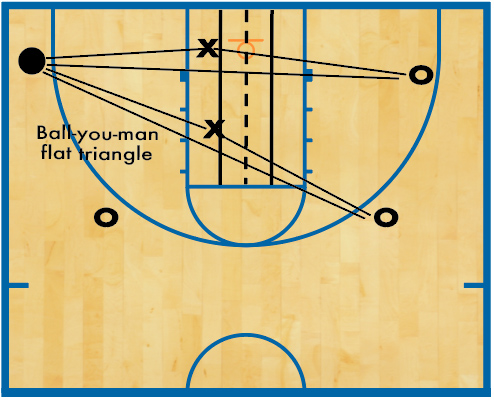
Those lines are called “one step ball side” (the line closest to the ball) and “one step man side” (the line closest to the defender’s man on the side opposite of the ball). This is shown in DIAGRAM 3.
Perimeter defenders guarding someone two or more perimeter passes away when the ball is below the free-throw-line extended should be in a “ball-you-man flat triangle” and “one step ball side” in a “pistol stance” while seeing both the ball and their man (DIAGRAM 4). Perimeter defenders guarding someone two or more perimeter passes away when the ball is above the free-throw-line extended should do the same in a “one step man side” position while seeing both the ball and their man (DIAGRAM 5).
Post and perimeter defenders can be involved in several different offensive scenarios. All of these could take place numerous times during a game, and everyone must be able to defend their man in all of these situations without thinking. The ball could either be above or below the free-throw-line extended, and that’s a major influence for every defender. Every different scenario forces the defenders to take different stances, positions and a readiness to utilize various defensive techniques to counter the offensive attack.
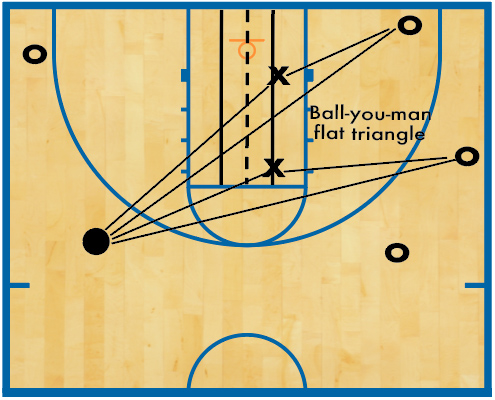
Another major concept emphasized is the further your man is from the ball, the further you are from your man. The point of emphasis is that all defenders anywhere on the court should always be able to see the ball and their man.
Defensive stance
Defenders of ball-side post players and defenders denying perimeter players one pass away from the ball should have similar stances. We want the perimeter defenders who are guarding a man one pass away to be in a more aggressive denial stance than other perimeter defenders who are further away from the ball. The same goes for defenders guarding ball-side post players versus post players who are on the offensive weak side.
Defenders guarding someone one pass away from the ball should be in a semi-crouch with the legs bent at the knees and feet shoulder width apart, with the defender’s belly facing toward the offensive opponent. The side of the defender’s body that is closest to the basketball is the ball side.
» ALSO SEE: Low-post defense and convert drill
Every defender must be able to see the ball and their man. We tell those defenders to look down the “long arm,” enabling them to see the ball. We tell defenders to have their “contact arm” bent at the elbow, with the forearm and the back of that hand making contact with the offensive player. And, we use the back of the hand to make contact, trying to keep them off balance. Using the back of the hand keeps us from grabbing the offensive player, preventing holding fouls. This allows the defender to see their man by feeling them with their contact forearm and hand, especially on backdoor cuts.
Defenders facing weak-side post or perimeter players two or more passes away from the ball should have similar stances. That stance should be the pistol stance, pointing and always seeing the ball and opposing player. Defenders again should be in a semi-crouch position with the feet shoulder width apart. The ball-side foot should be inches ahead of the other foot. The arms should be slightly bent at the elbow, with hands pointing (like a pistol) at both the ball and their man. The head should be up, looking straight ahead, but using peripheral vision while keeping their head on a swivel. If looking straight ahead compromises the defender’s vision, they should step back from the passing line to allow for better sight.
Offensive alignment
The offensive perimeter players that comprise this drill could be coaches, managers or players.
Most likely, offensive players will be located at both the mid- or low-post areas and at least one post player near the high post. The defensive players are the focal point of this teaching drill, with the perimeter players being support members.
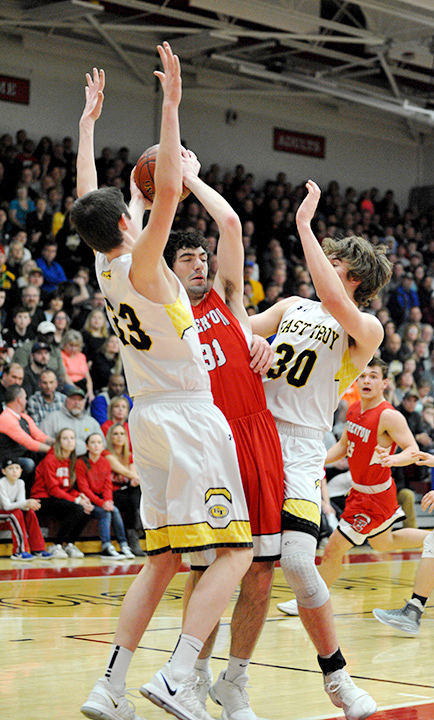
There could be perimeter defenders assigned to each of the offensive players. This would be more of a defensive perimeter shell drill. At the same time, these perimeter defenders could learn, practice, drill and reinforce the numerous facets of successful perimeter defense. This could include all perimeter defenders working on their proper position in relationship to the ball. Perimeter defenders could work on the appropriate stance while guarding their man, regardless of where the ball is located.
There are different scenarios for both post and perimeter defenders to work on. Perimeter defenders could either be guarding the ball, someone one pass away from the ball, a player two or more perimeter passes away, someone in the point area at the top of the key, someone near the wing area or in the corners while the ball could be located above or below the free-throw-line extended. All of these scenarios are possible during the course of a game.
Post defenders could be guarding someone ball side or weak side in the low, mid or high post. We strongly insist on calling the offense’s weak side the defense’s help side. This is to encourage the help-side defenders to be in the proper position and stance to help their teammates on the ball side.
When practicing, these defensive perimeter players are playing somewhat of a passive “dummy defense.” They should work on their techniques such as stance, location and other varied points of emphasis. These repetitions help develop the necessary instincts required for all successful defensive players. But they are not trying for steals and their offensive counterparts are in a controlled mode, not making this drill a half-court scrimmage.
Today’s game is played at such a rapid pace that there is no time for defenders to stop and think about the variety of ways an offensive player might attack. That’s why these scenarios must be practiced often. Players must exert physical effort while concentrating on the various points of emphasis. Coaches must make a commitment to teach, demonstrate, observe, evaluate, critique and correct each defender in every scenario.
For a coach to have a successful program, the initial step is to find the most efficient and effective way to play defensively. By choosing how to defend the various offensive schemes, a coaching staff can begin planning how to teach the players those techniques with the appropriate drills. Once those questions are answered, these teaching points can be incorporated with other drills to effectively teach, demonstrate and practice with the necessary intensity levels and repetitions to become a defensively solid basketball team.
John Kimble coached basketball for 20 years in Illinois and Florida, accumulating more than 340 wins. He has authored five coaching books, 90 articles and created 28 coaching videos. He can be found at www.CoachJohnKimble.com.









